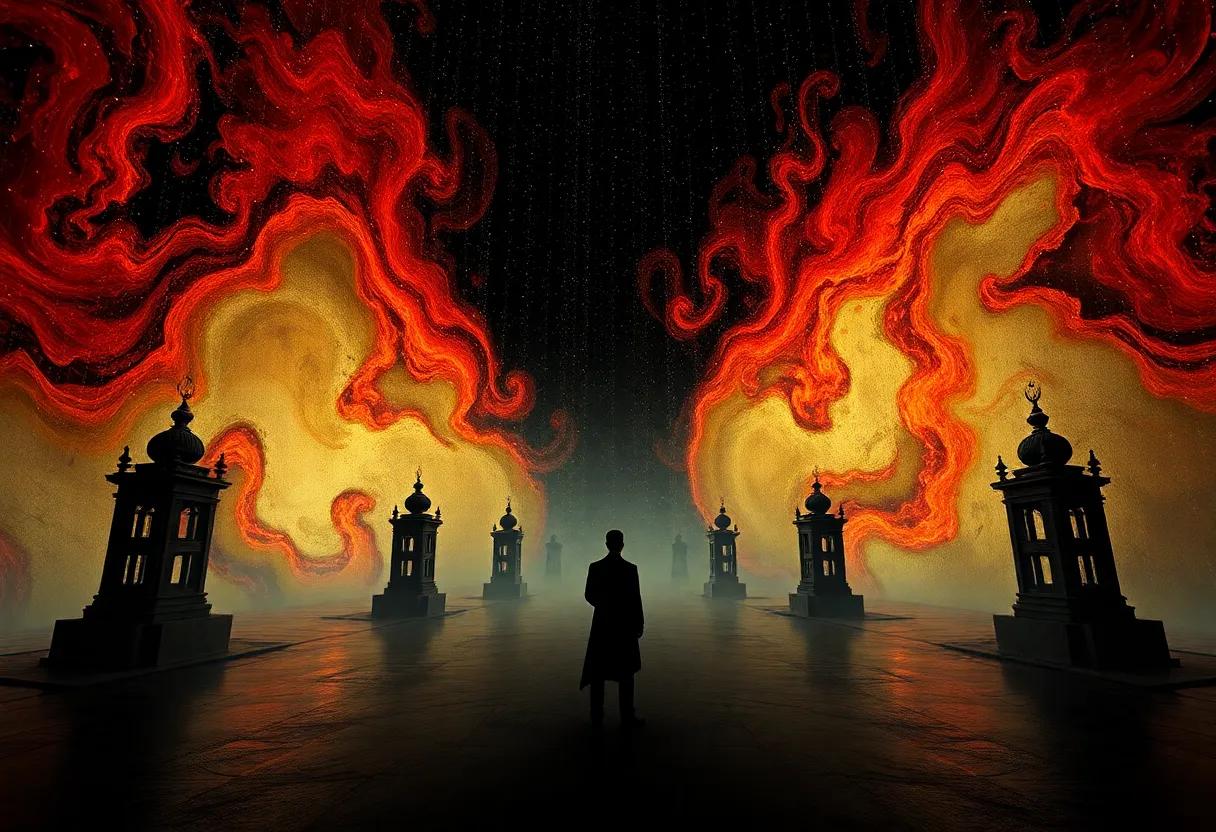In the vast landscape of contemporary literature, few works have sparked as much debate and reflection as Salman Rushdie’s The Satanic Verses. A novel that intertwines myth,religion,and identity,it challenges readers too navigate a tapestry woven with controversy and creativity. This review embarks on a journey through Rushdie’s provocative narrative, exploring the layers of meaning, cultural discourse, and artistic daring that have solidified the book’s place in literary history. Approaching the text with a balanced lens, we delve into the complexities that make The Satanic Verses both a masterpiece and a lightning rod of contention.
The Intricate Blend of Reality and Fantasy in The Satanic Verses and Its Impact on Narrative Structure
Salman Rushdie masterfully interweaves the tangible with the fantastical, creating a narrative landscape where reality and imagination blur to provoke both thoght and emotion. The novel’s structure mirrors this hybridity by oscillating between ancient events and surreal episodes, compelling readers to question the very nature of truth. Elements such as the magical transformation of characters and dreamlike sequences coexist with grounded depictions of culture and politics, resulting in a story that resists linear progression and embraces complexity. This fusion challenges conventional storytelling and invites audiences to embrace ambiguity, making the reading experience as much about interpreting meaning as following a plot.
- Nonlinear Narrative: Events unfold through jumps in time and perspective, reflecting the duality of the characters’ experiences.
- Mythical Allusions: Embedded within the story are references to legendary and religious motifs, enhancing thematic depth.
- Symbolic characters: Figures oscillate between realism and allegory, embodying both personal and cultural conflicts.
| Element | Reality Aspect | fantasy Aspect |
|---|---|---|
| Main Characters | Immigrants grappling with identity | Shape-shifting entities and angels |
| Setting | Urban London and Bombay | Dreamscapes and divine visions |
| Plot Devices | Political unrest and exile | magical events and prophetic dreams |
Deconstructing Religious Symbolism: How Rushdie Challenges Traditional beliefs Through Controversial Storytelling
Salman Rushdie’s narrative boldly reinterprets sacred motifs, daring to blur the lines between myth and reality.Through surreal episodes and allegorical characters,the novel challenges readers to reconsider the origins and implications of entrenched religious narratives. what sets this work apart is its unapologetic use of *magical realism* to question authority and orthodox doctrines without outright condemnation. by intertwining historical figures with fictional elements, Rushdie crafts a tapestry where faith is both deeply human and inherently fallible, inviting reflection on how stories shape collective belief systems.
- Symbolic Duality: The presence of conflicting divine messages underscores spiritual ambiguity.
- Fragmented narratives: The non-linear storytelling exposes competing interpretations within faith traditions.
- Subversion of icons: Traditional religious icons are reimagined, evoking both reverence and critique.
To illustrate how Rushdie destabilizes religious certainties, consider the following conceptual contrasts embedded within the text:
| Traditional Belief | Rushdie’s Interpretation |
|---|---|
| Unquestioned Prophetic Authority | Prophets portrayed with human flaws and contradictory impulses |
| Singular Divine Word | Multiple, competing revelations challenging one unified message |
| Fixed Sacred Texts | Texts presented as evolving myths shaped by cultural contexts |
Cultural Identity and Diaspora Explored Through Multifaceted Characters in The Satanic Verses
Salman Rushdie weaves a vivid tapestry of cultural hybridity through his richly drawn characters, whose lives oscillate between the familiar and the foreign.These multifaceted personas embody the tensions of diaspora-caught in the complex interplay between heritage and assimilation, past and present.Through characters like gibreel Farishta and Saladin Chamcha, Rushdie does not merely tell stories; he excavates the fragmented identities shaped by displacement and the search for belonging. The novel’s narrative structure itself mimics this fragmentation, blending the real with the mythical, reinforcing how cultural identity in the diaspora is anything but linear.
key facets of cultural identity examined include:
- Religious faith and doubt: questioning inherited beliefs while grappling with personal conviction.
- Language and dialog: the power and limitations of expressing oneself in a non-native tongue.
- Memory and nostalgia: the bittersweet pull of homeland memories versus present realities.
- Multiplicity of self: a kaleidoscope of identities that resist singular definition.
| Character | Symbolic Role | Reflection of Diaspora |
|---|---|---|
| Gibreel farishta | Mythic Messiah | Struggles with spiritual doubt amid cultural dislocation |
| Saladin chamcha | Anglicized Outsider | Embodies alienation and identity conflict in new world |
| Chamcha’s Father | Traditional Anchor | Represents generational tension and cultural roots |
The Role of magical Realism in Enhancing Themes of Faith, Doubt, and Redemption in Rushdie’s Work
salman Rushdie’s deft use of magical realism acts as a bridge between the tangible and the transcendent, allowing readers to navigate the murky waters of faith and skepticism. Through surreal episodes that shimmer with symbolism-such as the transformation of ordinary characters into mythical beings or the blending of historic events with fantastical narratives-the novel interrogates the tension between belief and uncertainty. This imaginative layering invites a multi-dimensional exploration of spiritual experience, where doubt is not merely a pitfall but an essential companion to faith, illuminating its fragility and resilience alike.
- Faith as a fluid spectrum: Characters oscillate between conviction and doubt,mirroring the real-world complexity of belief.
- Mythical dimensions: The novel’s blending of myth with reality deepens the allegorical resonance of redemption arcs.
- Symbolism of transformation: Personal metamorphoses reflect inner journeys toward forgiveness and salvation.
The interplay between magical realism and thematic development can be vividly captured in the following comparative framework, highlighting how particular narrative elements correspond to the broader motifs of faith, doubt, and redemption:
| Element | Faith | Doubt | Redemption |
|---|---|---|---|
| Magical Episodes | Divine signs and miracles | Inexplicable, surreal contradictions | rebirth after tribulation |
| Character Transformations | Epiphanies of belief | Internal conflicts | Forgiveness and renewal |
| Setting Shifts | Heavenly realms | Ambiguous, liminal spaces | Return to wholeness |
Examining The Satanic Verses as a Reflection of Postcolonial Tensions and Global Cultural Clashes
Salman Rushdie’s narrative intricately weaves the lived experiences of diasporic identity amidst the throes of cultural collision. The novel brilliantly captures the discord felt by immigrants straddling multiple worlds-a tension between inherited tradition and imposed modernity. At its core, The Satanic Verses destabilizes monolithic views of culture, instead presenting a kaleidoscope of beliefs, histories, and mythologies that refuse to coexist peacefully, reflecting the very real fractures of postcolonial societies on the cusp of globalization. The multifaceted characters embody struggles with faith, belonging, and transformation, symbolizing the broader conflict between colonial legacies and emerging global identities.
Several recurring themes offer insight into the novel’s exploration of cultural clashes:
- Hybridity and Displacement: Characters negotiate their place between worlds, neither fully accepted nor fully alien.
- Religious Ambiguity: Faith is portrayed not as a static doctrine but as a contested and evolving narrative.
- Power and Resistance: The novel probes how colonial domination continues to manifest in contemporary social tensions.
| Postcolonial Issue | Rushdie’s Reflection | Narrative Element |
|---|---|---|
| Identity Crisis | Blurring boundaries between self and other | Magical realism and fragmented storytelling |
| Cultural Hybridity | Embracing multiplicity rather than assimilation | Interwoven mythical and real-world elements |
| Religious conflict | Questioning sacred narratives | Controversial reinterpretations of scripture |
The Linguistic Craftsmanship Behind Rushdie’s Prose and Its Contribution to the Novel’s Evocative Power
salman Rushdie’s prose in the Satanic Verses is a masterclass in linguistic dexterity, weaving together a kaleidoscope of voices, registers, and styles that reflect the novel’s intricate thematic tapestry. His ability to oscillate between poetic lyricism and biting satire creates a dynamic rhythm that draws readers deeper into the narrative world. The layers of language not only enrich the storytelling but also invite multiple interpretations, offering a textual space where religious myth and personal identity intermingle. This craftsmanship extends beyond mere wordplay to a deliberate orchestration of syntax and diction, lending the text an evocative power that provokes and enchants concurrently.
- Interweaving narrative voices: From the mystical to the profane, Rushdie’s shifting perspectives echo the novel’s thematic collision.
- Lexical richness: Extensive vocabulary choices that create vivid imagery and subtle allusions.
- Rhythmic variety: Sentences that flow with poetic cadence alternated with terse, impactful statements.
To illustrate, consider this brief comparison of prose elements that emphasize Rushdie’s stylistic duality:
| Poetic Passage | Satirical Passage |
|---|---|
| “The city struck by a shimmering haze, where whispers of ancient myths threaded through the air…” | “Bureaucrats gawked like children at a magician’s trick, convinced that paperwork summoned divine interventions.” |
This juxtaposition is emblematic of Rushdie’s linguistic prowess-each mode amplifies the novel’s evocative potency, making the reading experience as intellectually stimulating as it is emotionally resonant.
Controversy and Censorship: The Political fallout Surrounding The Satanic verses and Its Global Reverberations
The publication of The Satanic Verses ignited a firestorm of political and religious tensions that rippled far beyond literary circles.The novel’s controversial reimagining of Islamic history was perceived by many as blasphemous, sparking widespread protests and calls for censorship that transcended national boundaries. Governments in various countries took drastic measures, banning the book outright and even prosecuting booksellers who dared to distribute it. At the heart of this clash was a profound debate over freedom of expression versus respect for religious sentiments, which continues to challenge societies grappling with multiculturalism and the limits of artistic licence.
Across the globe,the backlash manifested in an intricate web of diplomacy and defiance. notably, the fatwa issued against Salman Rushdie in 1989 underscored the volatile intersection of literature and geopolitics, leading to heightened security concerns and complex international relations. The following table outlines some of the most notable reactions and their geopolitical impact:
| Region | Response | Political Outcome |
|---|---|---|
| Iran | Fatwa and calls for Rushdie’s death | Strained relations with Western nations |
| india | Banned book and protests in multiple states | Heightened communal tensions |
| United Kingdom | Protected Rushdie under free speech laws | Debate over censorship and security intensified |
| Pakistan | book banned, public demonstrations | Increased pressure on government to act |
- Freedom of Expression: Championing literary innovation against cultural sensitivities.
- Religious Identity: defending faith amidst perceived external criticism.
- Political Diplomatic strain: Navigating the fragile balance of international outrage and protections.
navigating Themes of Myth and Modernity in The Satanic Verses With an Analytical and Respectful Lens
Salman Rushdie’s The satanic Verses dexterously weaves a complex interplay between myth and modernity, inviting readers into a realm where ancient narratives collide with contemporary dilemmas. The novel challenges conventional boundaries by juxtaposing Islamic lore with postcolonial realities, prompting a deeper reflection on identity, faith, and transformation. Through the characters’ surreal journeys and fragmented memories, the text explores how myths evolve, persist, or dissolve in modern societies, illustrating the fluidity of cultural storytelling. This tension between the sacred and the secular is not just literary but emblematic of wider societal shifts and the ongoing negotiation of tradition within modern frameworks.
Examining the text through an analytical and respectful lens allows for critical engagement without dismissal or prejudice.Some key themes emerge prominently in this context:
- Revisionist Mythology: Reinterpretation of religious stories to highlight the multiplicity of truth and belief.
- Postcolonial Identity: The struggle of diasporic characters confronting displacement and cultural hybridity.
- Faith Versus reason: The tension between personal belief systems and rational inquiry.
- Memory and Trauma: The juxtaposition of historical pain with contemporary existential crises.
| Element | Modern Reflection | Mythical Parallel |
|---|---|---|
| character Identity | Hybrid cultural selfhood | Divine-human ambiguity |
| Faith | Questioned and reconstructed | Immutable scriptural authority |
| Conflict | Internal and societal friction | cosmic and moral wars |
| Resolution | Ambiguous and evolving | Absolute and eternal |
The Emotional and Intellectual Journey Offered to Readers Through Rushdie’s Complex Narrative Choices
Salman Rushdie’s narrative intricacy serves as a powerful conduit, inviting readers into a labyrinth of layered storytelling that challenges conventional perceptions and evokes a spectrum of emotions. His intertwining of magical realism with historical and religious motifs does not merely advance the plot but acts as a mirror reflecting the complexities of identity, faith, and exile. Readers are often caught between conflicting realities and shifting perspectives,which fosters an intellectual engagement that demands active participation rather than passive consumption.This dynamic offers a space where disbelief and empathy coexist, encouraging deep introspection about the nature of truth and the fluidity of cultural narratives.
The emotional resonance of the novel stems largely from its refusal to provide easy answers, instead presenting characters and dilemmas wrapped in ambiguity and moral complexity. The juxtaposition of the sacred and the profane, reality and dream, compels readers to navigate a world where boundaries blur and certainties dissolve. This multifaceted approach can be distilled into several core experiences readers confront:
- Alienation and belonging: an exploration of displacement and identity politics.
- Faith and doubt: The nuanced interrogation of religious dogma.
- Memory and history: The subjective nature of remembering and retelling past events.
- Myth and reality: The collision between traditional stories and contemporary experience.
| Narrative Element | Reader Response | Emotional Impact |
|---|---|---|
| Magical Realism | Heightened imagination | Wonder and unease |
| non-linear Timeline | Cognitive challenge | Frustration and curiosity |
| Multiple Perspectives | Multiple interpretations | Empathy and disorientation |
Specific Reader Recommendations for approaching The Satanic Verses With Openness and Critical Thinking
Engaging with The Satanic Verses demands a delicate balance of openness and critical thinking, inviting readers to navigate its layered narrative without preconceived judgments. Approach the novel as a work of fiction that weaves historical,religious,and mythical elements into a complex tapestry rather than a factual account or manifesto. Embrace the ambiguity inherent in Rushdie’s storytelling and question the symbols and themes rather than accepting them at face value. Cultivating patience and curiosity will allow readers to appreciate the novel’s multifaceted explorations of identity, faith, and exile.
To aid in this process, consider the following practices:
- Contextual Reading: Research the historical and cultural background relevant to the novel’s controversial elements.
- Reflective Note-Taking: Jot down questions and observations as you read to revisit and analyze later.
- Dialogue Engagement: Discuss the novel with diverse perspectives to broaden your understanding and challenge your assumptions.
- Separate Art from Author: Appreciate the literary craftsmanship even when disagreeing with certain viewpoints.
| Tip | Why It Matters |
|---|---|
| Research Context | Unveils deeper layers behind controversial references. |
| Take Notes | Encourages active reading and critical thinking. |
| Engage in Discussion | Broadens perspective beyond personal biases. |
| Separate Art & Author | Allows appreciation of narrative complexity. |
Salman Rushdie The Visionary Author Behind The Satanic Verses and His Enduring Influence on Contemporary Literature
Salman Rushdie’s The Satanic Verses is more than just a novel; it is a complex tapestry woven from myth, history, and provocative allegory that challenges the boundaries of narrative and belief.Its intricate storytelling merges magical realism with intense cultural commentary, compelling readers to rethink established narratives and view religion and identity through a multifaceted lens. The book’s richly layered characters embody the tensions of displacement and transformation,creating an immersive experience that extends beyond the page. Rushdie’s bold approach provokes readers to explore the intersections of faith,skepticism,and artistic freedom,making the novel a landmark in postcolonial literature.
The enduring impact of The Satanic Verses on contemporary literature resonates through its stylistic innovation and fearless exploration of taboo subjects. Its influence can be traced through:
- The Revival of Magical Realism: Inspiring authors worldwide to blend the surreal with the real.
- Dialogues on censorship: Sparking worldwide debates on freedom of expression and the risks authors face.
- Multicultural Narratives: championing stories rooted in diaspora and identity conflicts.
| Aspect | Literary Influence |
|---|---|
| Genre Innovation | Fusion of Fantasy and Reality |
| Thematic Depth | Exploration of Identity and Faith |
| Global Reach | Translations in Over 30 Languages |
In weaving together the intricate tapestry of faith, identity, and imagination, The Satanic Verses remains as provocative today as it was upon its release. Salman rushdie’s novel challenges readers to confront uncomfortable questions, blurring the lines between myth and reality without offering easy answers. Whether approached as a work of literary artistry or a lightning rod of cultural debate, it demands engagement-inviting us all to explore the many facets of belief and dissent. this is a book that does not merely tell a story; it compels us to wrestle with the stories we tell ourselves.











